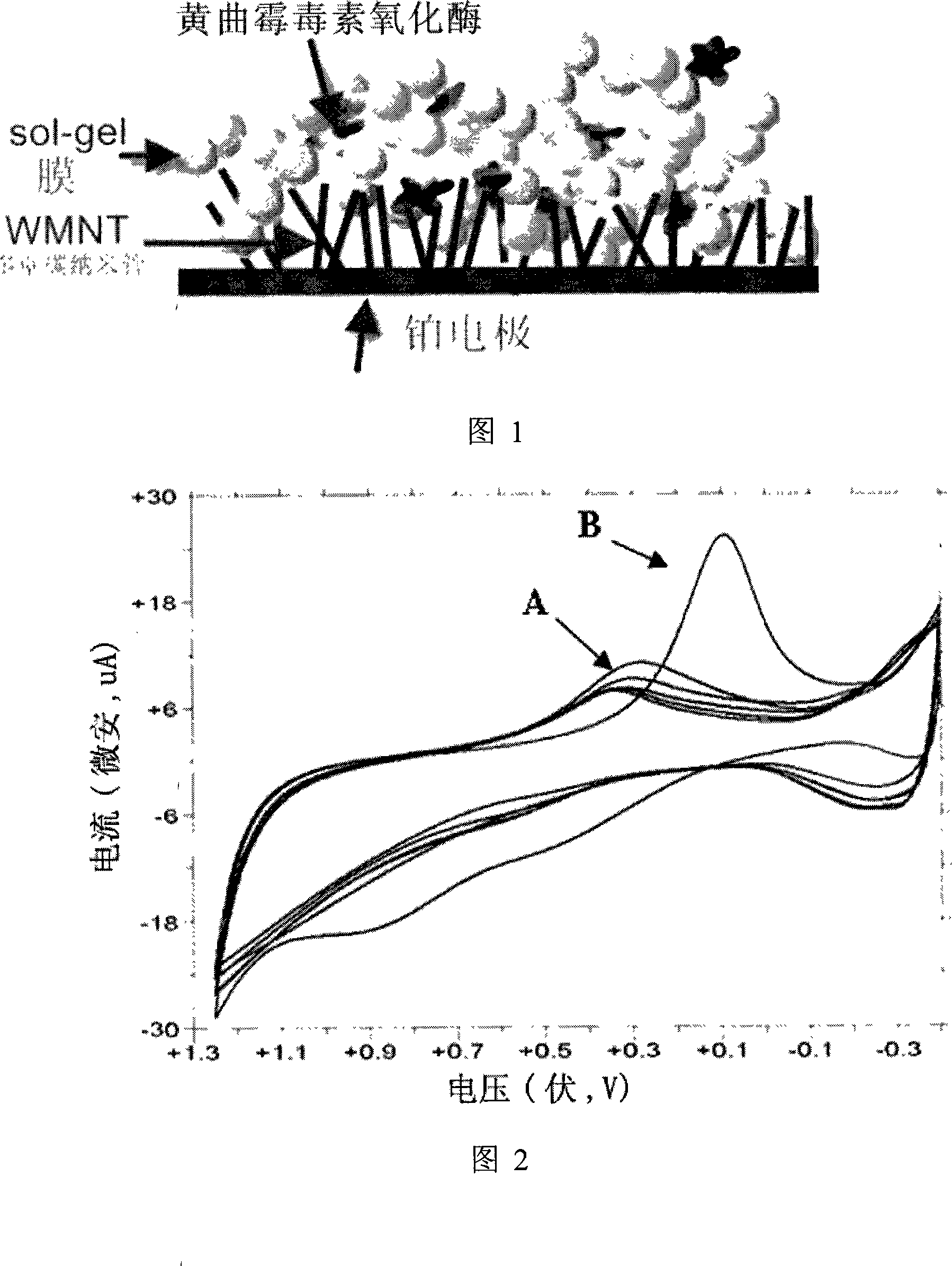Biosensor electrode for detecting aspergillus flavus toxin B1 and method for making same
An aflatoxin and biosensor technology, applied in the field of biosensors, can solve the problems of time-consuming, high technical level requirements, and cumbersome sample processing.
- Summary
- Abstract
- Description
- Claims
- Application Information
AI Technical Summary
Problems solved by technology
Method used
Image
Examples
Embodiment 1
[0058] Embodiment 1 is used for detecting aflatoxin B 1 biosensor electrodes
[0059] The present invention is used to detect aflatoxin B 1 The biosensor electrode comprises a base layer and a reaction layer formed on the base layer, the reaction layer includes an electron mediator, a sol-gel film and aflatoxin oxidase, the electron mediator is fixed on the base layer, and the sol-gel Glue embeds aflatoxin oxidase on the electron mediator modified substrate to form a film for the detection of aflatoxin B 1 enzyme-modified electrodes.
[0060] In this example, the electron mediator used is composed of multi-walled carbon nanotubes activated in an acid oxidation environment, specifically, carboxylated multi-walled carbon nanotubes obtained by nitration and oxidation activation treatment, which pass through the sol-gel Embedding and immobilizing aflatoxin oxidase.
Embodiment 2
[0061] Embodiment 2 is used for detecting aflatoxin B 1 Preparation of Biosensor Electrodes
[0062] (1) Preparation of materials
[0063] (1) Working electrode: Platinum electrode was selected and purchased from Tianjin Lanli Technology Company.
[0064] (2) Multi-walled carbon nanotubes (MWNTs): purchased from Shenzhen Nanoport.
[0065] (3) TEOS (tetraethyl orthosilicate, tetraethyl orthosilicate) was purchased from Sigma Company.
[0066] (2), preparation of carboxylated multi-walled carbon nanotube solution
[0067] Reflux the multi-walled carbon nanotubes (MWNT) with aqua regia for 8-10 hours, centrifuge at 10,000 g for 15 minutes, discard the supernatant, wash the precipitate with double distilled water, centrifuge at 10,000 g for 15 minutes, and wash the precipitate. The precipitate is dried in an oven to obtain carboxylated multi-walled carbon nanotubes.
[0068] Weigh 1 mg of the above-mentioned carboxylated MWNT and dissolve it in 10 ml of pure water containing...
Embodiment 3
[0077] Embodiment 3 is used to detect the experimental analysis of the biosensor electrode of aflatoxin B1
[0078] The aflatoxin oxidase-modified platinum electrode described in the present invention is used as a working electrode to form an electrode system together with a common counter electrode and an optional reference electrode.
[0079] In this embodiment, the Ag / AgCl electrode is selected as the reference electrode, the Pt wire electrode is used as the counter electrode to form a three-electrode system, and the phosphate buffer is used as the electrolyte.
[0080] (1) Processing of samples:
[0081] Solid sample: 100g sample is pulverized with a pulverizer, fully dissolved and shaken with methanol:water=45:55 volume ratio, extracted 3 times with an equal volume of chloroform, passed through a funnel containing anhydrous sodium sulfate, blown nitrogen at 65°C and evaporated to dryness .
[0082] Liquid sample: 100ml sample was extracted 3 times with 0.5:1 (volume:vol...
PUM
 Login to View More
Login to View More Abstract
Description
Claims
Application Information
 Login to View More
Login to View More - R&D
- Intellectual Property
- Life Sciences
- Materials
- Tech Scout
- Unparalleled Data Quality
- Higher Quality Content
- 60% Fewer Hallucinations
Browse by: Latest US Patents, China's latest patents, Technical Efficacy Thesaurus, Application Domain, Technology Topic, Popular Technical Reports.
© 2025 PatSnap. All rights reserved.Legal|Privacy policy|Modern Slavery Act Transparency Statement|Sitemap|About US| Contact US: help@patsnap.com


